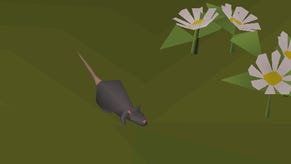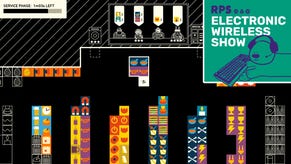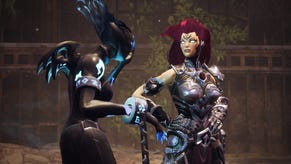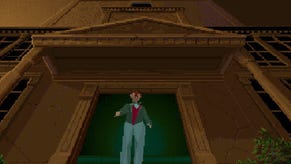Alone In The Dark review: a neatly crafted reboot that seems afraid to step into the unknown
Bad manors
Detective Edward Carnby looks very different these days, and not only because he’s made of a lot more polygons. Gone are the professorial waistcoat and bow tie of his angular 1992 incarnation, replaced instead by the grubby suit of a life-bruised 1930s noir PI, complete with hipflask of brandy for when the stress of being unaccompanied with the lights out gets too much.
Carnby isn’t the only one who’s transformed in this reboot of Alone in the Dark, the classic survival horror avant la lettre, either. Veterans will find plenty of callbacks and familiar names as they poke around its Louisiana manor house – talk of the Pregzt Shipping Company might raise an eyebrow, for instance, as may the gnarled tree filling much of the conservatory. But like these, everything here is remixed, rewritten, relocated. Indeed, Decerto house is no longer empty but a ‘home for the mentally fatigued’, while player characters Carnby and Emily Hartwood now arrive together, since she’s hired him to help check on her uncle, a long-term resident who may be in danger.

Given this reworked scenario, you may surmise correctly that you won’t be on your tod quite as much as the game’s title suggests. Still, you can’t blame developer Pieces Interactive for filling out their story with extra characters, given that the original’s is rather bare bones by today’s standards. The period setting certainly doesn’t hurt in this respect, blending Agatha Christie and H.P. Lovecraft as staff and patient alike give off a whiff of suspicion whenever you run into one. It’s a fun production that gently sends up its literary and cinematic inspirations without relinquishing darker plot strands.
In an equally expansive vein, you aren’t limited to touring the house and its immediate surroundings this time either, as otherworldly forces ping you to dreamlike distortions of reality, from New Orleans streets to a crashed steamboat and further flung locales. By the time the first such journey occurs, you’ve learned that Jeremy has gone missing, and with your chosen character now separated from their partner, you finally get to go solo. Again, it feels like a smart decision to branch out in this way, heaping up a sense of the uncanny while allowing for greater variety in scenery and level design.
On the downside, however, the division between what you do in the house compared to the external sequences is a little too pronounced. For the most part, the monsters you inevitably encounter only exist in those faraway places. Occasionally, finding a key item or solving a puzzle in Decerto causes a small pocket of the dreamworld to erupt around you, and you have to despatch a few ghouls to restore normality. But otherwise the house itself is oddly safe, like a Resident Evil game in which someone has herded all the zombies below stairs, and no amount of creaky ambience can convince you otherwise.



Exploring the house thus tends to boil down to the mechanics of the exercise – plenty of map reading, loads of matching keys with doors, and a smattering of puzzles. And while it’s all neatly arranged, there’s not much among these pieces to set either the pulse or the brain racing. On a few occasions, a ‘puzzle’ equates to picking up an item, such as a switch lever, and ferrying it a few yards to its home. More cerebral activities, meanwhile, tend to fall into two camps – deciphering short passcodes from clues or placing and rotating tiles to form a picture. Logical they may be, but it’s such standard fare that, when one puzzle has you fixing a literal boiler plate, you might conclude there’s elaborate self-parody afoot.
This refusal to push the envelope causes Alone in the Dark to stumble elsewhere too. Over 30 years on from the original, it enters a world in which the rules of survival horror have not only been well-rehearsed but shaken around like a snow globe by the likes of Alan Wake 2. Yet despite the freshly cooked, self-aware story elements, the playing experience often feels as traditional as the décor in Decerto, with modernisation mostly taking the form of quality of life and labour saving shortcuts, rather than anything more daring.
Navigation and combat are a case in point. On the one hand, Carnby and Hartwell struggle around minor obstacles and could barely mount a kerb if it wasn’t marked by a button prompt. Surely we’re used to survival horror protagonists showing a touch more initiative and athleticism these days? They are, however, quite nimble when faced with the game’s hostiles – dark things that come in roughly humanoid, animal or insectoid forms – with a quick duck away enough to put distance between you and their fiendish aims in most circumstances, and instant weapon switches that shift you from stand-your-ground gunfire to bludgeoning melee strikes. As in many a survival horror, you have to make shots count and avoid being swamped, but it’s all a little basic and neither especially horrifying nor tough to survive.
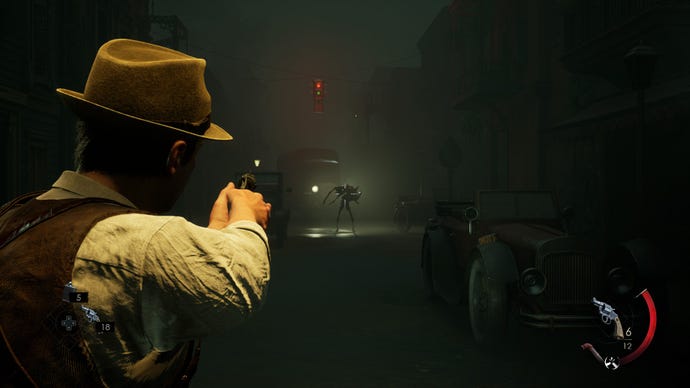
Then again, perhaps the absence of anything more demanding or ambitious is for the best, as Alone in the Dark is also straitjacketed by technical limitations. Yes, this is a handsome game, with Decerto in particular drawn in the kind of detail that might see you distracted by wallpaper textures or volumetric light pouring through windows. Yet scenes are prone to moments of debilitating frame judder when the camera rotates quickly – regardless of the video settings, I couldn’t banish it completely – and characters and monsters alike get snagged and stuck on furniture from time to time. It feels like scenes might break down if further strain was placed on the engine, as if it really were a period production, running on smoke, mirrors and stuntmen in rubber costumes.
Yet while, like the Carnby of old, this latest stab at Alone in the Dark ialas somewhat stilted and conservative, there’s still enough here to make its breadcrumb trail enticing. The two main characters are a draw, for sure, not least thanks to the voice performances (and likenesses) of David Harbour and Jodie Comer. Each provides a different window into this world when you pick them for a play through – Carnby is determined to earn his fee, in over his head, probably drunk; Hartwell quickly starts to wonder if she’s imagining all the weird stuff thanks to a family history of insanity. They’re different to control too, with Emily quicker on her feet, and with unique story scenes filling gaps in the other’s experience, they make a decent case for playing the whole thing twice.
It helps also that the latter stages of the game capitalise on groundwork laid in the more predictable first half. The locations you find yourself sucked into become that bit more intricate, with multi-part puzzles to wriggle through, and some combat situations that force you to move through the gears. Plus, each time you reemerge in Decerto, with everyone else none the wiser as to what you’ve been up to, the notion that the whole thing might be in your head starts to grip. True, there’s nothing especially original about a story that blurs the lines between madness and the paranormal, but it does inject doubt and paranoia into your investigation, which only makes you long to unravel the truth more. While spending time alone in the dark may not be as uncomfortable as it should be this time, then, with all the changes it may still be worth peering into the void, to see what returns your gaze.
This review was based on a review build of the game provided by publishers THQ Nordic.



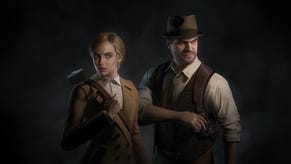
.jpg?width=291&height=164&fit=crop&quality=80&format=jpg&auto=webp)
